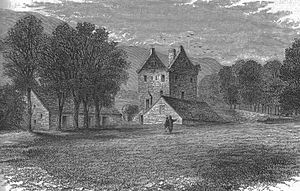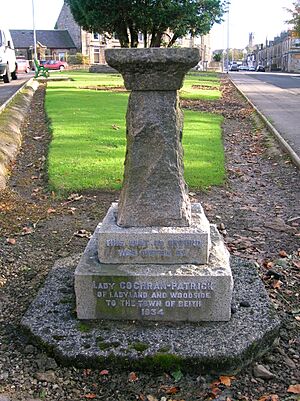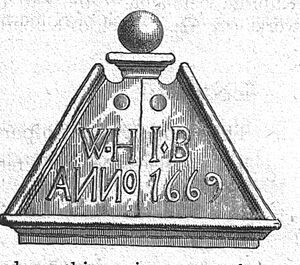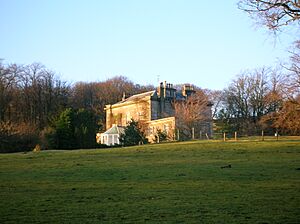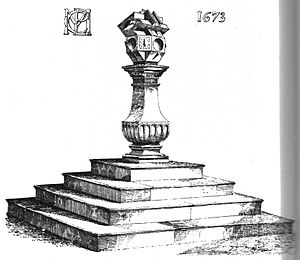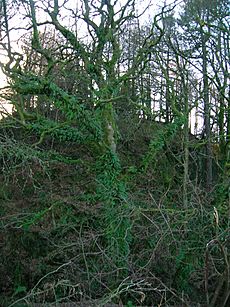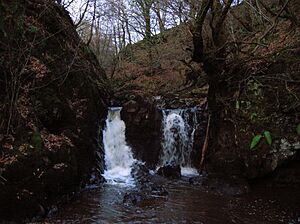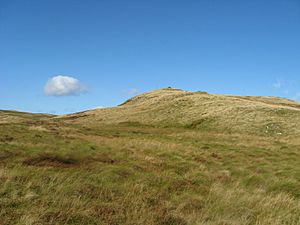Barony of Ladyland facts for kids
The Barony of Ladyland was a special area of land in old Scotland. It was part of the feudal system, which was how society was organized long ago. Ladyland was located near Kilbirnie in what is now North Ayrshire, Scotland.
Contents
What is the History of Ladyland?
Who Owned Ladyland?
In the Kilbirnie area, there were three main land divisions called baronies: Kilbirnie, Glengarnock, and Ladyland. The first owners of Ladyland were a branch of the Barclay family from Kilbirnie. Archibald Barclay, a second son, was given the Barony of Ladyland by his father, Sir Hugh Barclay.
David Barclay of Ladyland was with Mary, Queen of Scots, in May 1568. He likely fought at the Battle of Langside, where the Queen's side lost. After this, she had to leave Scotland.
Hugh (Hew) Barclay of Ladyland was a poet known for his humor. He was a strong supporter of the Catholic faith. His brother, Sir David Barclay, took over Ladyland after Hugh. David married Elizabeth Cunningham. Sadly, David's son, also named David, inherited many debts. He had to sell Ladyland to John Blair of Cloberhill to pay them off. This was the end of the Barclay family's time owning Ladyland. By 1654, Sir David Cuninghame owned Ladyland.
The Hamilton Family at Ladyland
Captain William Hamilton was the first of the Hamilton family to own Ladyland. Lieutenant William Hamilton, a poet, also owned Ladyland. He was a friend of the famous poet Allan Ramsay. In 1722, William Hamilton published a shorter version of the story of William Wallace. This book made a young Robert Burns very interested in Scottish history. Burns later wrote that it "poured a Scottish prejudice in my veins."
John Hamilton, who was the 8th of Ardoch and 2nd of Ladyland, sold Ladyland around 1712. He bought land in Northern Ireland and named it Ladyland there. The Hamilton family became well-known in Ireland, and the name Ladyland still exists. John Hamilton then sold Ladyland to Henry Moncrieff, who later sold it to Alexander, the 9th Earl of Eglinton.
The Cochran-Patrick Family at Ladyland
William Cochran bought Ladyland around 1718 from the Earl of Eglinton. He lived there with his wife, Margaret Orr. Their son, also named William, took over in 1756. In 1803, his son William inherited Ladyland. He married Catherine Hamilton, a distant relative of the earlier Hamilton owners.
They had two daughters, Agnes and Janet. Agnes inherited Ladyland when her father died in 1832. She married William Charles Richard Patrick. He added his wife's last name to his own, becoming Cochran-Patrick. This started the Cochran-Patrick family line.
Robert William Cochran-Patrick (1842–1897) was a very educated man. He studied at Glasgow University and Cambridge. He returned to Ayrshire to live as a country gentleman and study old things like archaeology. He was known for collecting old Scottish coins and medals. He also wrote books about Scottish money. Robert was a Member of Parliament for North Ayrshire from 1880 to 1885. He was also involved with the Irvine Burns Club and the Spier's school in Beith.
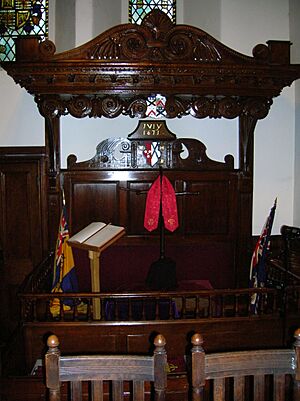
What Happened at Ailsa Craig?
Hugh Barclay of Ladyland, who was Catholic, got involved in a secret plan in 1592. When it was found out, he was put in prison in Edinburgh. He was released in 1593 after promising to behave. However, Hugh got involved in another plot. He was imprisoned again in Glasgow Castle but escaped. He then fled to Spain and talked with Jesuits, a Catholic religious group.
In 1597, Hugh came back to Scotland. He and others took over Ailsa Craig, a small island. He planned to use it as a stop for a Spanish invasion. The goal was to bring the Catholic faith back to Scotland. This plot was originally started by some powerful Earls.
Hugh was discovered on Ailsa Craig by Andrew Knox, a Protestant Minister. It is believed that Hugh died accidentally while trying to escape. Some say he fell into the sea and drowned. Andrew Knox was accused of Hugh's death. However, the King decided that Knox's actions were "loyal and good service" to the King and country. The King protected Knox from any further trouble. Hugh Barclay was a close friend of the famous poet, Alexander Montgomerie.
What is Ladyland Castle Like?
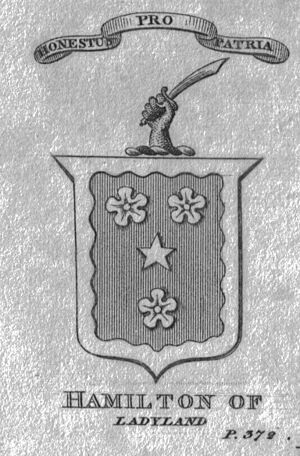
Ladyland Castle was the main building of the Barony of Ladyland. It was a typical tower house from the 1500s. It probably had three floors and a defensive wall around the roof. Each corner might have had a small tower. The castle was likely changed in 1669 to be more comfortable and less like a fort. This was for William Hamilton of Ardoch, who bought the property.
A new, more impressive door was added on the first floor. Above it, a stone is carved with "W.H. I.B." and the date 1669. This refers to William Hamilton and his wife, a Barclay. This carved stone is still there today, above the gate to the walled garden.
The castle also had low buildings on each side, possibly for stables or storage. A sundial from 1673 still exists. It might have been built to celebrate the castle's "modernization." In the walled garden, another stone from 1817 has the initials "W.C. C.H."
In 1815, workers found a hidden space in one of the castle walls while it was being partly taken down. Inside were four small pots, a painted drinking glass, and a large jaw bone. Two of the pots had handles and were sealed with cloth. One pot held chicken bones, and the others had greasy soil. A coin was also found nearby, but its details were too worn to read. No one knows why these items were there.
A part of the old castle still stands today. It is about 20 feet long and 25 feet high. It forms the north side of the walled garden. It has a gun port (a hole for a gun) and a rectangular window. There are also some square holes that were likely for bees.
In 1691, records show that Ladyland had ten fireplaces. Eighteen other homes were also part of the estate. In 1841, W. C. Patrick of Ladyland helped strengthen the walls of Glengarnock Castle. This is noted on a plaque there.
What is Ladyland House Like?
Ladyland House is a beautiful country house about two miles from Kilbirnie. It was designed by the architect David Hamilton for William Cochran. A special feature of the house is the large columns on each corner. The windows have a unique "tartan-checked" pattern.
The stables nearby were designed later, around 1860-1861. They were made to look similar to the main house. The stables have now been turned into private homes. They might even include some parts of the original 17th-century buildings. The main house was built between 1816 and 1821. In 1925, a new section was added to blend with the old house. The house was bought in 2017 by Dr. Kiril Sharapov and Colin Burden.

Ladyland Sundials
There is a Scottish sundial at the stables from 1821. It might have been made to celebrate the completion of the building work. Another beautiful sundial from 1673, originally from the old castle, now stands in front of the mansion house. The older sundial has the letters "M.P.C." on it.
Ladyland's Natural Surroundings
The Ladyland Burn (a small stream) flows through the area. Its name might come from an old chapel that was there long ago. The Maich Water starts from Mistylaw Muir and flows through a pretty valley nearby. It has a small reservoir upstream. The Maich Water forms the local boundary here and flows into Kilbirnie Loch.
The Smuggler's Cave is next to the Maich Water. It used to be reached through an entrance with sandstone pillars. The main entrance road to Ladyland from Ford Cottage looks very grand. The 'Sheep Linn' is a waterfall on the Maich Water, above Cockston Farm.
Plants and Wildlife at Ladyland
The Scottish Wildlife Trust has marked these areas as a special wildlife site. Many rare plants can be found here, including:
- Whorled Caraway (Carum carvi)
- Fragrant Orchid (Gymnadenia conopsea)
- Aspen (Populus tremulans)
- Ivy-leaved Crowfoot (Ranunculus hederaceus L.)
- Dovedale Moss or Mossy Saxifrage (Saxifraga hypnoides)
- Hairy Stonecrop (Sedum villosum)
- Wilson's Filmy Fern (Hymenophyllum wilsonii)
- Bay Willow (Salix pentandra)
- Beech Fern (Phegopteris connectilis)
- Oak Fern (Gymnocarpium dryopteris)
- Mountain Pansy (Viola lutea)
Interesting Stones and Old Finds
Near the Ladyland Burn, hidden under some trees, is the 'De'il's Chuckie Stane.' This stone is shown on old maps. It has a mysterious name, but no old stories explain it. 'Chuckie' means a pebble, often a white stone, but this stone is not white. Its name might suggest that the 'De'il' (Devil) was a giant.
The Cat Craig is next to the path leading to Cockston farm. It is one of two rocky areas enclosed by drystone walls. The name 'Cat' is often used for stones and might come from 'Cath,' a Celtic word meaning 'battle.' Old maps show a 'Castle Hill' across the Maich Water from Cockston Farm. This might make the name 'Cat Craig' more understandable.
Around 1810, Mr. Cochran of Ladyland removed a pile of stones (a cairn) near Ladyland. He was improving the farmland. Inside, he found a pot with burnt bones. At Ladyland itself, a small bronze axe was dug up. It was given to the National Museum of Antiquities of Scotland in 1886.
Images for kids
On the hills above Ladyland, you can see signs of ancient farming. These marks were once called 'Elf furrows' because people didn't understand how they were made.
Other Interesting Facts
Captain William Hamilton was a privateer, meaning he was a private ship owner allowed to attack enemy ships. He fought for William and Mary after King James II left the throne. He was killed in 1689 while fighting French ships off Ireland.
The Cochran-Patrick family's ancestors originally lived at Edge. Its ruins are still on the hillside near Muirshiel Country Park.
In 1811, J. Cochrane experimented with improving rough hill pastures. He used a small mountain stream to water the land. This greatly improved the grass, allowing a good hay crop. His neighbors thought it was too expensive, but he proved them wrong.
On top of Little Auchenbourach hill, there is a pile of stones (a cairn) surrounded by metal railings. A plaque on it remembers William Arthur Cochran-Patrick. He was born in 1860 and died in 1881 at age 20. A Latin message on the plaque means "You were loved by all." William's friends and the people who rented land from Ladyland paid for this monument.
Eleanora Cochran-Patrick married Sir Neil James Kennedy. He took his wife's last name to keep the old family name alive.
In June 1911, the Misses Cochrane-Patrick were driving home in their carriage. Their horse got scared by a dog and fell, overturning the carriage. Miss Harriet Cochrane-Patrick, who was driving, was thrown out, and a wheel went over her shoulder. Her sister was trapped under the carriage. A coachman quickly held the horse down, and others helped free the ladies. The coachman hurt his hand. The horse was badly injured, and the carriage was smashed. The ladies were taken home and treated by a doctor and nurse. They were both bruised and in shock, but luckily no bones were broken. Both sisters were well-liked for their charity work in the Kilbirnie and Beith areas.


